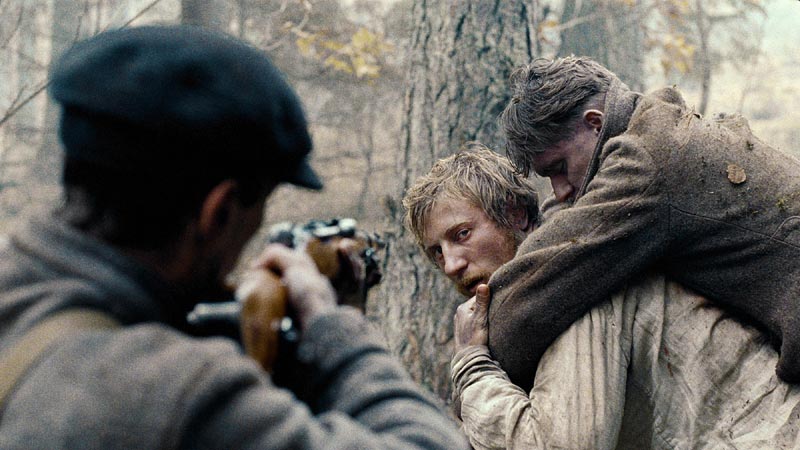The film is based on a book by Belarussian
author, Vassily Bykov, one of Belarusia's most famous authors who drew on his
real life experiences during World War II for his material.
The setting is the German occupied Western
frontier of the USSR,
present day Belarus,
in 1942. Local pro-Soviet partisans are
fighting against the occupying Germans in a campaign that is long and
brutal.
When a train is derailed a village a rail
worker, Sushenya, is arrested by mistake together with a group of
saboteurs. The saboteurs are hung but
the German officer in charge realizes that Sushenya is innocent and to
everyone's surprise, lets him go.
But this is just the beginning of Sushenya's
problems because no one believes that he was just let go as an act of
mercy. Everyone believes that he must be
a German collaborator.
Weeks later partisans Burov and Voitik
arrive and take Sushenya into the forest to shoot him. But events take an unexpected turn when the
group is attached by a group of pro-Nazi fighters. In the ensuing battle all three men are
wounded and left to survive in the forest.
Thrown together with the same fate, they have to decide moral questions
about crime and punishment and guilt and innocence. We see the lives and the moral decisions that
the three men have had to take in a series of flashbacks about their lives.
Russia
has a long and glorious tradition of great war films from this period so
Loznitsa has chosen a genre where he has a lot to live up to. But the director soon takes the story into
another dimension that goes beyond the war film and becomes a film about the
choices men make in brutal conditions and under totalitarian regimes. Is anyone really guilty or innocent?
Speaking during the press conference Loznitsa
said that the film was not about war.
"The film is about people who find themselves in certain
conditions. This generates and
atmosphere. What happens can happen at
any time and in any society."
Loznitsa chose his cast from Russian
theatre actors and they turn in stunning performances as the three wounded men,
especially Vladimir Svirski as Sushenya.
The film was shot by Oleg Mutu who also
shot another Cannes
competitor this year, Cristian Mungiu's Beyond
the Hills. The film was shot in 72
long takes and the highly talented and obviously much in demand Mutu gives In the Fog his distinctive look and
style. Despite being set in Belarus
the film was shot in Lativa where the director said he found the forests that
he needed.
Sound also plays a big role in the
film. Loznitsa said that sound was very
important in this films. He said: "I
treat sound as you would treat music in my films. That's why I don't' need music in my films
because the sound is sufficient." The sound in In the Fog took three months to complete.
Loznitsa said: "If I have to sum up what
the film is about I would quote from the author Bykov who said that a man is
capable of everything, but there are situations when he is capable of
absolutely nothing."
Credits:
Russia, Germany, Latvia,
Netherlands, Belarus
Director: Sergei Loznitsa
Screenwriter: Sergei Loznitsa
DoP: Oleg
Mutu
Production: Ma.ja.de Fiction, Belarusfilm,
GP Cinema Company, Lemming Film, Rija Films (www.rijafilms.lv)
Cast: Vladimir Svirski, Vladislav Abashin
and Sergei Kolesov
 CANNES: Ukrainian documentarist turned
feature director Sergei Loznitsa returns to Cannes with a war drama, In the Fog, after having taken home the
Best Director's prize two years ago for his debut feature, My Joy.
CANNES: Ukrainian documentarist turned
feature director Sergei Loznitsa returns to Cannes with a war drama, In the Fog, after having taken home the
Best Director's prize two years ago for his debut feature, My Joy.
Published in
Region



















